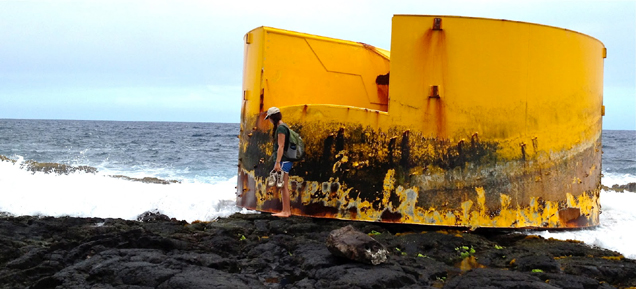Photos courtesy Ka’u Calendar and DLNR | Voice of Julia Neal
NAALEHU, Hawaii: A huge, metal “pontoon” has washed up on the rocky shore of Naalehu in the Ka’u district of Hawaii Island, and residents are wondering if the marine debris is the result of the March 2011 tsunami in Japan.
UPDATE (Oct. 8, 2012): In its first official media release on the object, the Department of Land and Natural Resources says:
The Department of Land and Natural Resources (DLNR) is examining its options for removal of a large circular yellow metal container measuring approximately 10 feet high and 20 feet in diameter which washed ashore on the lava shore four miles south of Na’alehu in Ka’u district, south Hawai’i. A report was made to the department on October 4, from a caller who said he had seen it at Waikapuna on September 27. Hikers had also discovered the object on Wednesday, Oct. 3.
A DLNR Big Island staff member was able to locate the object on Friday at the end of a fishing trail on private land. There were no signs of any identification marks so its origin at this time is unknown. There were also no signs of marine life growing on the container, which appeared clean except for minimal algal growth.
DLNR has asked various local maritime agencies for assistance to identify this type of large object. NOAA is also checking its database of reported tsunami debris objects.
As Julia Neal reports in the Friday (Oct 5) Ka’u Calendar news brief:
The giant container like object is metal, yellow, about 12 feet tall and 20 feet wide and could possibly be a pontoon for a floating dock. It was discovered Oct. 3 on state property, within the wash of the waves. Hikers came across the possible tsunami debris along the shore makai of Na’alehu, on the uninhabited Ka`u Coast.
No official word from the Department of Land and Natural Resources on whether or not the pontoon is from Japan. On Friday in Honolulu, a 20 by 6-foot F/V Zephyr skiff was brought in to harbor by a Hawaii longline fishing vessel, after it was found 700 nautical miles northeast of Maui. The skiff was confirmed having been washed away during the tsunami. The DLNR says it was registered in the Iwate Prefecture.
William J. Aila, Jr., DLNR Chairperson, said, “The State of Hawaii is grateful to the Japan Consulate for their continued excellent assistance to confirm origin of this item and contact the owner. This is believed to be the second confirmed piece of Japan tsunami marine debris in Hawaii.”
Last month, a large blue plastic fishing bin was the first officially confirmed piece of Japan tsunami marine debris.
According to DLNR, other items include “pieces of Styrofoam, large buoys typically used in oyster farming, a large rubber float, a beer crate, tire, plastic containers, hard hat, and large light bulbs. In most cases it is extremely difficult to determine whether debris came from the tsunami, without unique identifying information. Many of these items have washed up on Hawaii’s shores prior to the tsunami.”
DLNR also put together these tips:
HOW TO REPORT FINDINGS OF POSSIBLE JAPAN TSUNAMI MARINE DEBRIS:
The public is invited to contact DLNR at (808) 587-0400 to report findings of possible tsunami marine debris. If possible, we request that a picture of the debris with a detailed description of the object, date found, location and finder’s contact information, be sent to dlnr@hawaii.gov . This information will help DLNR staff to determine if a more thorough investigation is necessary. If you find a debris item that can clearly be traced back to an individual or group and has monetary and personal value, please report it to DisasterDebris@noaa.gov with relevant information. Recent examples of personal items found include a motorcycle and a soccer ball.
More detailed guidelines on reporting and/or handling marine debris can be found at http://marinedebris.noaa.gov/tsunamidebris
FACTS ABOUT JAPAN TSUNAMI MARINE DEBRIS:
The State of Hawaii is also collaborating with the Papahanaumokuakea Marine National Monument as well as external stakeholders to assess and monitor the movement of other Japan tsunami marine debris. The Government of Japan estimated that the tsunami swept approximately five million tons of debris into the Pacific Ocean and that about 70 percent sank quickly. The remaining 1.5 million tons dispersed far across the North Pacific ocean. Models and estimates completed by NOAA and the University of Hawai‘i reveal that some high-floating debris may have passed near or washed ashore on the Main and Northwestern Hawaiian Islands as early as this summer. During the summer, debris was found along the Pacific Coast of North America from Alaska southward to California.Because most tsunami debris was washed out to sea before the release of radioactive materials from the power plant and because of its extended exposure to the elements, it is highly unlikely that the debris would be contaminated.
Even though the likelihood of discovering radioactive contamination on marine debris is low, the state Department of Health has been conducting shoreline surveillance since April 2011, in order to establish normal background radiation levels around the islands. The state Department of Health continues to conduct quarterly shoreline environmental surveys on O‘ahu, Maui. Kaua‘i, and the Hawai‘i Island. Results of the surveys performed displays consistency with normal background radiation levels. Additionally, the state Department of Health has partnered with NOAA to perform shoreline and debris monitoring on the Northwestern Hawaiian Islands.


by Big Island Video News10:49 pm
on at
STORY SUMMARY
Photos courtesy Ka’u Calendar and DLNR | Voice of Julia Neal NAALEHU, Hawaii: A huge, metal “pontoon” has washed up on the rocky shore of Naalehu in the Ka’u district of Hawaii Island, and residents are wondering if the marine debris is the result of the March 2011 tsunami in Japan. UPDATE (Oct. 8, 2012): In […]